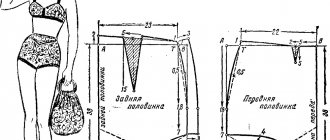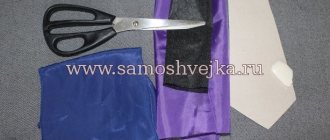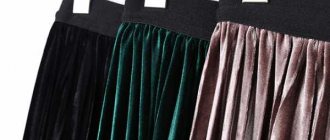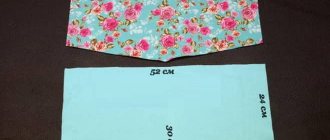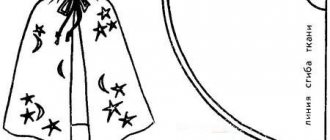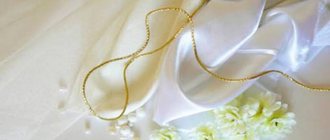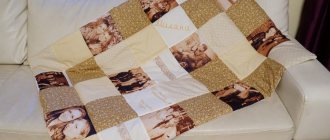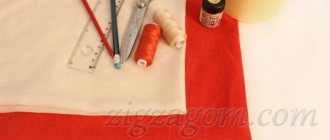Stores offer beautiful but standard curtains for decorating houses and apartments. But you want your own home to be not just cozy and beautiful, but unique and individual, reflecting the inner world of the owners and based on their preferences. There is one way to make such a dream come true without spending all your savings on it: sewing the curtains yourself. This task is within the capabilities of any person who has the desire to create. Tips on what exactly to create and how to do it effectively can be found in our article.
Ideas for sewing curtains: which curtains you can sew yourself
Ideas for your own creativity can be drawn from the history of curtains: from animal skins with which caves were hung to the lush decorations of palace halls with luxurious tassels, draperies and multi-layered compositions. Modern technologies make it possible to use new materials for curtains: wrinkle-resistant, non-flammable and not exposed to ultraviolet radiation. Current fashion trends regarding curtains return to the old days, when great attention was paid to textile decoration.
Curtains with lambrequin
Curtains with a decorative lambrequin are most often used in living rooms.
But, due to the fact that a lambrequin can not only decorate a window and give it a complete look, but also has quite practical functions: it hides cornices and curtain fastening systems - it can be used in all rooms.
The only condition is compliance with the style of the room in shape, choice of material and design. Lambrequins with draperies are appropriate in the central room; they will create an atmosphere of comfort and luxury in combination with other interior items.
A rigid lambrequin frame - a gang made of fabric or plastic - can be used in the kitchen and bedroom.
Roman style
The highlight of Roman blinds is a specific fabric made from noble types of dense fabric: jacquard, satin, muslin with a large geometric pattern or without a pattern. Practical Roman-style curtains in a modern apartment, designed in ethnic or minimalist style, look organic on the balcony, kitchen, bathroom and library, as well as in the living room and bedroom.
English style
For those who want to give their home an aristocratic spirit based on a combination of simplicity and nobility, English-style curtains will appeal. The basis of such curtains is a smooth rectangular fabric. Cords threaded through sewn rings are controlled by a lifting mechanism, thereby creating pleats: wavy, bow-shaped or puffed. The number of folds may depend on the size of the window opening or the preferences of the owners.
Classic
Classic curtains, made of two panels, are the simplest option, but also the most popular. Various methods of fastening: loops, ties, drawstrings, eyelets - make the classics not boring. By making classic curtains double-sided, you can increase their functionality and decorativeness.
From two long, even canvases, you can use various technical devices to create style compositions:
- "hourglass";
- Japanese curtains;
- Italian curtains.
The location of the curtains determines the choice of fabric, which can be the simplest: linen or chintz and the most respectable: brocade, satin, velor, wool.
French curtains
The curtains, based on the traditions of lush France, are gathered along the entire length to form narrow scallops. Such curtains are sewn - “awnings” from soft, elastic fabrics: tulle, satin, silk, voile, chiffon, organza. “Marquise” is a curtain for those for whom beauty in the interior is ahead of functionality.
Preparing for work (choosing fabric, creating a pattern)
The main difference between curtains and other types of curtains is that they are always sewn from light translucent fabrics. The material for them must be selected taking into account the style of the interior and the main palette of the kitchen. But do not forget that the curtains in the workroom have to constantly suffer from hot steam, smoke, splashes from frying pans and pots. Therefore, in addition to color and pattern, it is important to choose the right fabric, which will get dirty less and better withstand numerous washes without losing its appearance. Organza, linen or synthetic mesh, polyester, nylon, transparent veil are suitable.
Ideally, either pure synthetics or mixed fabrics should be used for sewing kitchen curtains.
Taking measurements
To sew kitchen curtains with your own hands, you will need to measure the window opening. This is especially important for complex bay windows, where the frames can have different widths and even shapes. In a standard kitchen, the width of the curtains is usually determined by the size of the cornice or simply chosen 10 cm larger than the window itself. In terms of length, it is better to make the canvas slightly below the window sill (from 2 to 15 cm) or flush with it. Curly arched curtains are calculated in exactly the same way, but along their long sides.
After taking measurements from the windows, prepare a template so that when cutting you do not get a skewed pattern or the wrong direction of the threads. The material itself should be hand washed and ironed before use. When transferring the pattern to the fabric, also do not forget to set aside 2 cm on each side for finishing the edges. It’s not difficult to sew the curtains yourself – all you need to do is sew over the edges. And the formation of draperies, folds and other “beauties” will depend on the method of attaching the window opening or bay window to the cornice. And this is where the fun begins...
Fabric consumption for curtains
The process of making curtains should begin with the purchase of fabric. Even if the choice is a simple model, it is necessary to correctly calculate the required amount of fabric for sewing.
The main parameters that you need to pay attention to are the width of the canvas and the direction of the pattern on it. If there is a desire to make drapery in your plans, use the assembly coefficient (CF), which is expressed in the ratio of the cut to the width of the finished curtain. To determine how much fabric to buy in this case, you need to multiply the finished width of the curtain by the KS.
CS depends on the type of fabric:
- for curtains it is 1.7;
- for tulle with a pattern – 2;
- for tulle without a pattern - 3.
Sewing simple and beautiful curtains - step-by-step instructions
If you do not want to create complex and binding compositions, you should opt for simple designs that can be decorated with delicate bows. Very often, such curtains are used to create a cozy interior in the kitchen. For this reason, very often you can hear from housewives the question of how to sew simple and beautiful curtains for the kitchen with your own hands. Simple curtains can have an unpretentious appearance, but they will be both beautiful and ideal for decorating a kitchen space. If you want to decorate the curtains, you can additionally use a variety of decorative elements for this purpose, which will give the curtains uniqueness and add a special zest to the interior.
The fabric for making sheets should be chosen in a width that corresponds to the window opening in the kitchen
On a note! The fabric for making canvases should be chosen in a width that corresponds to the window opening in the kitchen.
The length of the curtains in the kitchen is selected by housewives to their taste. Depending on the overall interior of the room, you can make curtains that are short or up to the window sill. If necessary, you can decorate the windows in the kitchen with floor-length curtains. If desired, kitchen openings can be decorated with a narrow ribbon made of satin. This tape is sewn to the curtain fabric using threads of the appropriate color.
Lightweight curtains for kitchen windows can be perfectly combined with blinds of various designs and with tulle. You can decorate the curtains in the kitchen with the help of bows, which can add uniqueness and tenderness to even the simplest curtain.
You can choose any fabric for making curtains for the kitchen at your discretion. It should be noted that the best material option for making curtains for the kitchen is blended or cotton fabric.
This type of fabric perfectly allows air to pass through, which creates an atmosphere of lightness in the room. Ribbons made from satin are recommended for use as decoration; when choosing a satin ribbon, it is advisable to give preference to contrasting colors.
Lightweight curtains for kitchen windows can be perfectly combined with blinds of various designs and with tulle
To sew a curtain, you should take the fabric prepared for this and smooth it, and then baste the entire perimeter with the exception of the top edge.
After basting the entire curtain around the perimeter, hem the top edge in accordance with the width of the cornice on which it is planned to fasten the curtain.
Curtains on a roll
The range of curtain fabric in rolls has three standard widths:
- 1.40 m;
- 2.80 m;
- 3m.
If the length of the intended curtain fits into the given width and the pattern is located from edge to edge, the fabric is calculated using the same formula as tulle: cornice width x KS (for curtains it is 1.7).
The calculation of the fabric will be different if the pattern is located along the edge and the width of the roll is less than the height of the future finished curtain. When sewing several fabrics together, you should remember to match the pattern between them. In this case, you will need more fabric - exactly 1 repeat, that is, a completed fragment of the pattern.
We analyze the difficult moments of sewing curtains for the living room
Sewing curtains for the living room yourself requires care, although it is not as difficult as it seems at first glance. First of all, we will need a sewing machine, it’s good if it is quite expensive and of high quality, then there will be fewer problems in the process. With a good machine, it’s easier to sew and the curtain will turn out better. For those who have rarely used a machine to make seams, it is better to practice on a piece of fabric, this way your hand will become full and fewer mistakes will come out in the process.
If you want to make beautiful cuts, then learning how to use an overlocker is not difficult. Curtain models for the living room with such ends look much better. It is more difficult to sew curtains with hems; for beginners, the edges may come out crooked, and the seam “walks” from side to side. If you don’t follow the process, then such curtains can only be used as rags in the garage, and not hung on windows.
Patterns of curtains for the living room will help you cope with sewing faster if you have experience in this matter. The seams along the edges should be made small, one millimeter each.
When this is done for the first time, it is better to iron the edges of the material so that the hem is the same everywhere. The ribbon should also be sewn only after preliminary marking on the layer; you can secure the ribbon with pins. A pattern for curtains for the living room is more practical than a pattern and is a ready-made version of the model.
The living room and its curtains can serve as a starting point for gaining experience for those who are learning this business for the first time. It is better to start sewing simple curtains, and then gradually move on to more complex ones. It is also optimal to practice on curtains for a small window, where you can stop in time and start again in case of failure. The cornice and type are also important to consider - different fastenings require different sewing of the top edge and different cutting.
If you want to make lambrequins, then you need to think a hundred times - the task is not easy and not for beginners. There are a lot of nuances to consider here:
- Material used for sewing;
- The size of the future lambrequin and folds;
- Location of the grain thread and curtain model.
httpv://youtu.be/1ImOahFnsyo
So if you have little experience in this matter, then it is better to first seek help from a specialist - an experienced seamstress who will tell you how and what is best to do so that the finished result is pleasing to the eye. In the workshop, a seamstress will tell you for an additional fee how to sew curtains for the living room with your own hands well and correctly. As for buying ready-made options, the price of curtains for the living room is 1000 rubles and increases depending on desire and imagination.
Direction of the pattern on the roll
The direction of the pattern, or rapport, in a roll can be:
- from edge to edge;
- along the edge.
If the pattern on the roll has a transverse direction, then the width of the fabric is equal to the height of the finished curtain. Payment is made per linear meter of curtain width. This option is suitable if there is a need to make a curtain for a very wide window.
If the pattern is directed along the roll, then the width of the fabric is equal to the width of the finished curtain. Payment is made per linear meter of curtain height. This option limits the width of the curtain, but is suitable for sewing curtains with a ceiling of any height.
Pulling the edges
To pull back the edges of the curtains, weights in the form of metal discs or chains are used. The weight of the weight is selected depending on the weight of the fabric and the length of the curtain.
Metal discs are used when sewing long and heavy curtains. Often these weights have holes, which makes them easier to attach to the fabric. They can also be placed in the curtain lining (if provided), in the side seams or in special pockets.
To make a pocket, two pieces of fabric are cut out in accordance with the size of the disk and taking into account seam allowances. The pocket is sewn on three sides, turned inside out, and a weight is placed in it. The pocket hole is sewn up and it is attached to the edge of the curtain.
Chains are used when sewing light curtains and are placed in the inside of the hem during the formation of the hem. The chain must be cut so that it is shorter than the curtain. It is secured with stitches by hand.
How to make a pattern
If the idea of ready-made curtains has formed in your head, everything you need for sewing is ready, you should go to the store to buy fabric.
It is first necessary to make calculations so that the money spent on the purchase of fabric is not wasted: due to a shortage or excess of material.
Fabric calculation examples
To calculate the fabric you will need the following parameters:
- the height of the product equal to the distance between the floor and the curtain rod hooks, minus the distance between the floor and the lower edge of the curtain;
- a width equal to the length of the cornice - from one extreme hook to the other.
So, we determine that the height of the finished product will be 2 meters 60 centimeters. The width of thick curtains will be 5 meters 10 centimeters, according to calculations: 3 * 1.7 = 5.1, where 3 m is the length of the curtain rod, and 1.7 is the gathering factor recommended for this type of fabric.
In the store we purchase fabric 5.1 m long with a standard roll width of 2.8 m.
Uncover
Before you start cutting, to avoid subsequent shrinkage, you should wet the fabric, squeeze it lightly and leave it wrapped in a towel for several hours. Then take out the fabric and iron it from the inside out.
Prepare the necessary tools:
- large scissors;
- a piece of soap;
- safety pins;
- meter;
- ruler.
When cutting parts, it is necessary to focus on the direction of the grain thread so that the product does not deform during operation. Cutting start with large canvases:
- Lay the fabric on the floor, wrong side up;
- Place the pattern pieces on the fabric.
- Trace them with soap, taking into account a 1cm seam allowance.
- Leave 10 cm at the top and bottom of the canvas.
- Leave 4 cm for processing the sides.
How to sew double curtains: instructions, fabric patterns, examples and photos
Double curtains are a great option for the bedroom and living room. To sew them you will need two types of fabric. One is with a geometric or floral print, and the second is plain.
A prerequisite is that both fabrics must be combined in texture and color.
A brief description of how to sew double curtains.
- Determine the width and length of the product.
- Measure the length of the plain product, taking into account the allowances for finishing the ends.
- Connect the curtains with a short seam 1/10 of the entire length.
- Place the bottom part.
- Place the colored fabric on top of the plain fabric and stitch along the top edge.
- Sew each colored fabric to a plain one so as to give it volume.
- At the top of the wrong side of the product, secure the tape with several lines.
You can endlessly fantasize and experiment with them, playing with different combinations of colors and fabrics.
Fabric hem
To ensure that the result does not disappoint, it is very important to correctly fold the fabric, according to the rules:
- A double hem makes the edge of the curtain even, but it is not suitable for curtains with interfacing.
- Basting should be done with long stitches to avoid deformation.
- Before ironing the hems, it is better to secure the curtain with pins.
- Before hemming the bottom edge of the curtain, let it hang for a couple of days.
Hemming can be done using a sewing machine with a zigzag stitch, adhesive tape, or by hand using a hem or blind stitch.
Curtains with hinges
Curtains with hinges are an option for framing windows in a studio apartment of a young family, a kitchen space or a nursery. The peculiarity of this type of curtain is that, apart from the fabric, no additional devices are required. A hinged curtain is a processed fabric with decorative loops.
A step-by-step master class will help you understand the intricacies of this simple process:
- Cut out 2 pieces of fabric using the above cutting technology.
- Sew the upper part of the fabric, preparing a piece - a strip of fabric with a length equal to the width of the curtain and a width of 10 centimeters.
- Glue non-woven tape onto the strip.
- Hem the curtains at the top and bottom, turning the edges inside out twice.
- Determine how many loops you will need, taking into account that their standard width is from 6 to 7 cm.
- Prepare the blanks, taking into account that the width of each blank will be equal to: 6*2+1.5=13.5 cm.
- Fold each piece in half, wrong side up.
- Sew, retreating from the edge 1.5 cm.
- Turn right side out and fold so that the seam is at the back.
- Make markings on the canvas for the location of the loops.
- Place the loops on the front side of the fabric with the cuts facing up and secure with pins.
- Place a strip of fabric prepared for facing on top and stitch along the top line, retreating 1.5 cm from the edge.
- Fold the strip to the wrong side, iron and baste from the wrong side.
- Thread the loops onto the cornice.
Gatherings and pleats
How much fabric should I take for the window? It is believed that if the curtain is to be gathered, the width of the canvas should be 2-2.5 times wider than the cornice. However, if there are both curtains and curtains on the window, it is enough to take 1.5 times more fabric. The same proportions are recommended if the fabric has a large pattern, which will not be visible when the fabric is pulled tightly together. For curtains with eyelets, fabrics are taken 2 times the width of the cornice.
The top edge of the curtains is folded using curtain tape, which gives the living room a festive look. Unlike assemblies, they have a more regular shape and are located directionally. The upper edge of the fabrics is treated with adhesive interlining or edging 7-10 cm wide, after which the folds are fixed on the wrong side and stitched to the height of the interlining. Do not make markings with abrasive crayons; traces of them may remain on the fabric even after washing.
The most elegant types of folds are:
- Inverse (counter). On the front side, the folds of the fabric are directed towards each other.
- One-sided. They are laid in one direction at the same distance. They can be directed from both sides to the middle of the canvas, where the central - counter fold is located.
- Bow ones. On the front side, the folds of the fabric are directed in different directions. They are placed at equal or different intervals, sometimes without them at all.
- Shells. They have a smaller volume and are suitable for bright fabrics. They are stitched from the front side to the width of the beading at a distance of 15 cm from each other and a dense gasket is inserted inside the resulting cavity.
It may also be interesting: How to choose lambrequins for the kitchen?
Designers advise not to deepen the folds by more than 14-20 cm, and the narrower the window, the smaller they should be. Decorative braid or curtain tape is attached to the upper part. If it is loose, steam it. It may be made from fabric that shrinks.
Folds are used in the manufacture of lambrequins. It should be no more than 1/5 of the curtains in height. Sometimes folds are assembled by hand, without using a sewing machine. If the width of the fabric is not enough, grind the fabric down and make sure that the seam is inside the fold. It should be borne in mind that the denser and heavier the material, the worse it drapes. Rigid lambrequins with complex assemblies are made using special templates. It is difficult to do it yourself with high quality without special skills; it is better to entrust it to the masters.
How to sew curtains with ribbon
Curtains on ribbons specially designed for draping and hanging on curtain hooks are the simplest option for window decoration. Simplicity of design is in no way related to decorativeness, which is ensured through the selection of fabric, trim and accessories.
First of all, you need to measure the width of the cornice and the height from the floor to the cornice, and take into account the fabric for the top and bottom trim. Create a pattern and prepare two identical fabrics.
The curtain tape is sewn according to this algorithm:
- Lay out the fabric with the wrong side up, and apply the tape also with the wrong side up on the top edge of the fabric.
- Carefully fold the top edge 2-3 cm, catching the edge of the braid.
- At a distance of half a centimeter from the fold, stitch the top of the ribbon, then the bottom of the ribbon.
- Release the cords, fold the side edges of the fabric 1.5-2 cm over the braid and stitch.
- Iron the finished curtains, observing the temperature conditions.
- Tighten the cords, forming even folds across the entire width of the curtain.
- You can do without additional costs and hang the curtain from the loops located on the tape on the hooks located on the cornice.
The classic version of curtains with hinges can be diversified with interesting hooks. You can make them from soft toys, artificial flowers and decorative ribbons.
Embroidery will turn a simple curtain into a designer one.
The work invested in creating a cozy family nest will be justified by the admiration and respect of loved ones.
Step-by-step procedure for sewing curtains with your own hands
Following the step-by-step procedure, you can independently sew curtains for the hall or living room, obtaining an original and stylish product. For your first creative experiment, it is best to choose a simple and easy-to-implement sketch, and try your hand at clearly reproducing the instructions:
- selection of ideas and materials for future work, preparation of additional accessories for subsequent fastening of finished curtains in the open state;
- taking measurements and choosing the length of the curtains; at this stage, the need to process the seams should also be taken into account, so the material is purchased with allowances calculated;
- cutting according to dimensions and a sketch prepared in advance; when placing all the elements, do not forget about allowances and arrange them correctly;
- processing all edges on a sewing machine, you can use the overlock function or turn the edge 2 times by 0.5-1 cm for easier stitching;
- a special tape is sewn to the top of all elements, with an indentation of 1-2 cm, the threads should match the tone of the fabric and not stand out against its background;
- assembly of the finished structure and hanging, before this the fabric must be steamed, avoiding overheating with the iron and other damage.
It is important to correctly calculate not only the width of the curtains, but also their length so that they fit perfectly into the interior composition. After sewing one simple model, you can complicate the task and take on a more complex task, design and make multi-layered products to decorate other rooms.
Stylish combined curtains made from several types of materials look great in a classic living room or hall decorated in the Baroque style. For modern and simpler interiors in a modern style, lighter and airier materials, natural fabrics and simple textiles are suitable. Having chosen a specific design, you can sew different components and elements yourself, assembling an original design that will bring comfort to your home.
Selecting curtain rods
Gone are the days when curtains were hung on a string. Sewing a curtain by investing effort, time, and imagination into it is half the battle. It is also necessary to select a cornice that will not only allow you to attach the curtains, but will also create a harmonious duet with them: it will emphasize the beauty of the curtains and enhance the visual effect. Maybe it will just become a reliable mount that will be completely invisible.
The usual round cornices, the basis of which is a pipe, are a classic of the cornice genre. This type of cornice is a self-sufficient element of the interior. Made of wood, natural color or tinted, with decorative carvings and vintage fastenings, it goes well with heavy curtains of noble colors and shades, made in a classic style without an abundance of decoration.
String cornices are a solution for fans of high-tech style and minimalism. These are inconspicuous designs, without a hint of decorativeness. Curtains made of modern materials: light, metallized, simple and at the same time elegant will take their rightful place on it.
Cornices made of aluminum profiles successfully combine high practicality and uncomplicated decorativeness. Their main advantage is any size and ability to take any shape. Curtains made of light fabrics look elegant on them, but they can successfully withstand any dense fabric. Curtains on such curtain rods play a “solo” role. You should only take into account the combination of cold aluminum with fabric colors in soft pastel colors and a copper shade of “demanding” gold, purple and burgundy.
Baguette cornices, richly decorated with stucco, carvings, made of natural wood or high-quality artificial materials, are intended for formal rooms decorated with curtains made of velvet and brocade, the finest organza and tulle. The cornice, in which all the fastenings are hidden under the decorative strip, should fit into the interior with heavy furniture and antique paintings.
If the baguette is white and smooth, it is a completely suitable option for a bedroom with Japanese-style curtains - simple ones made of unbleached linen.
Forged - works of blacksmithing, can be powerful, with deliberately rough processing.
They can be very thin with openwork elements.
These designs fit well into modern and traditional styles. Curtains that contrast in style, color and texture will look especially impressive on such cornices. Light weightless tulle will only benefit from a metal background, and a heavy velvet curtain on heavy forged rings in a wooden house will be a bright accent that completely transforms the space.
When selecting cornices for curtain masterpieces created with your own hands, it is also worth showing your imagination, moving away from stereotypes and creating your own unique ensemble.
How to sew curtains yourself
When choosing a type of window decoration, you need to take into account your degree of skill. To begin with, you should not choose complex models; it is better to sew a simple curtain, inventing original decorative elements for it.
Straight curtains
Even a novice craftswoman can create such a model. At the first stage, you need to determine the dimensions of the future product: you need to measure the length of the cornice and the distance to the floor. To get neat folds, you need to take a piece of fabric whose width will be 2 times the length of the cornice.
When calculating the fabric, it is important not to forget about the allowances that will be used to form the seams. Usually leave 5 cm for the side parts, 15 cm for the bottom and top edges. After calculating the dimensions, you can buy fabric and start sewing.
Main stages of work on the product:
- The fabric must be moistened and ironed before cutting;
- A piece of fabric is laid out on a flat surface, the necessary fabrics for curtains are cut out;
- The fabric is ironed again and the seams are sewn;
- A curtain ribbon is sewn on top of the product;
- Form folds and hang the curtain on the cornice;
How to hang curtains
To hang curtains correctly, you need to understand the mounting methods. The most common in terms of simplicity, reliability and invisibility are hooks, most often plastic. They are attached to the curtain and cling to the curtain rod. They can withstand any type of fabric, but are not durable. If they break, they are easy to replace, as they are affordable.
Clips are fabric clips that have teeth. They withstand curtains better, but their drawback is that they can damage the fabric with sudden movement.
Eyelets are special rings sewn into the fabric that make it possible to easily string the curtain onto a tubular cornice. The curtain will be securely fastened, and the waves of the fabric will stand in a strict geometric order. This type of fastening is suitable for all rooms; inserting rings into the fabric is not difficult. Eyelets are designed for durable fabrics; metal will weigh down light fabrics.
Decorating your own home is an activity not only for a housewife, but also for a real lady. Using recommendations and advice, anyone can handle sewing stylish curtains in their free time. In an interior in which soul and effort are invested, the quality of life improves.
